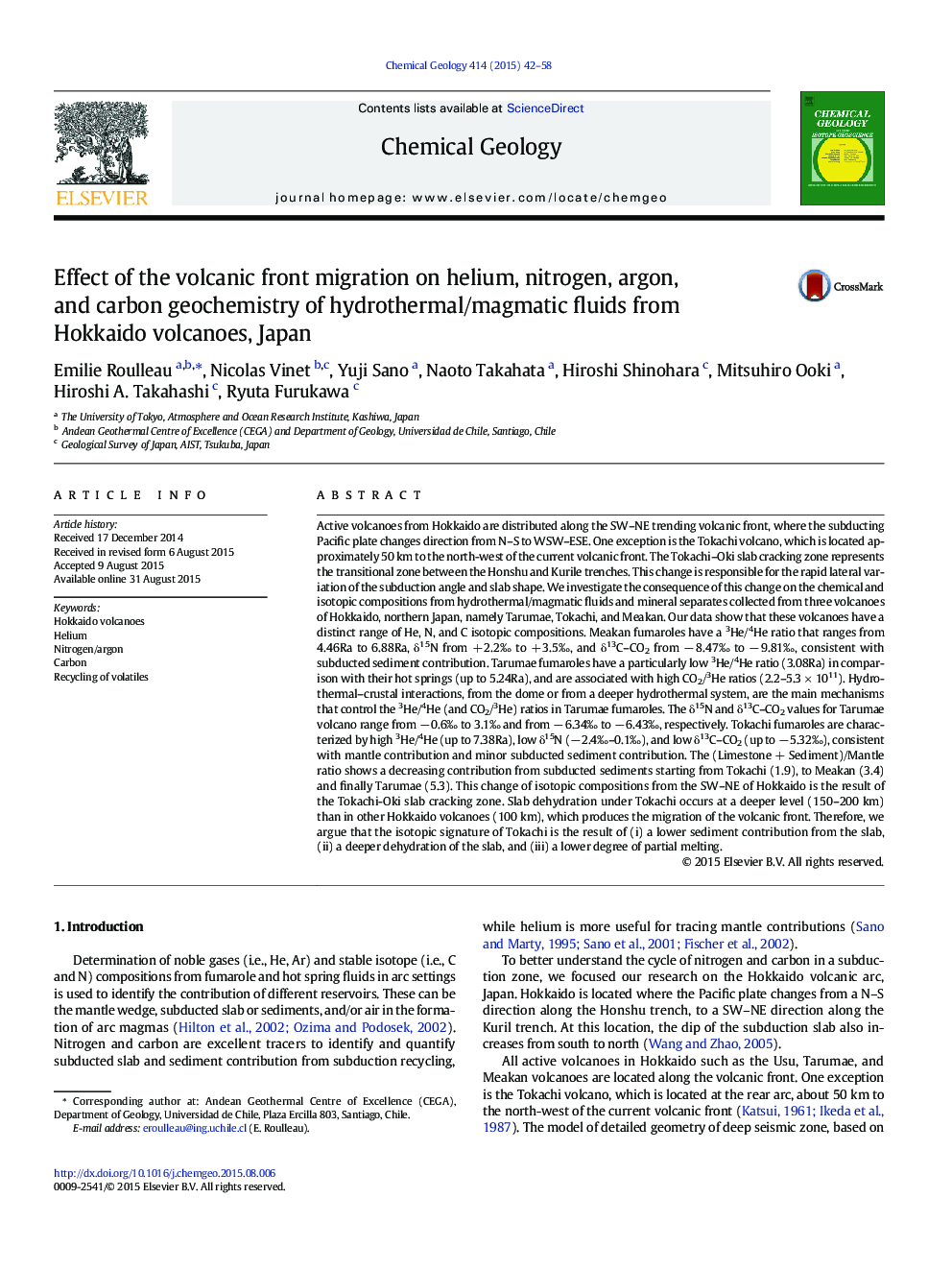| کد مقاله | کد نشریه | سال انتشار | مقاله انگلیسی | نسخه تمام متن |
|---|---|---|---|---|
| 4698449 | 1637560 | 2015 | 17 صفحه PDF | دانلود رایگان |
• We present He, Ar, N and C isotope compositions of hydrothermal fluids and rocks from Hokkaido volcanoes, Japan.
• Tarumae fumaroles show low 3He/4He and high CO2/3He ratios due to hydrothermal–crustal interaction.
• Tokachi fumarole compositions are consistent with a major mantle contribution.
• Hydrothermal fluids from Meakan reveal a major contribution from subducted sediments.
• Changing of the Pacific plate direction in Hokkaido is responsible for the variations of composition of the hydrothermal fluids.
Active volcanoes from Hokkaido are distributed along the SW–NE trending volcanic front, where the subducting Pacific plate changes direction from N–S to WSW–ESE. One exception is the Tokachi volcano, which is located approximately 50 km to the north-west of the current volcanic front. The Tokachi–Oki slab cracking zone represents the transitional zone between the Honshu and Kurile trenches. This change is responsible for the rapid lateral variation of the subduction angle and slab shape. We investigate the consequence of this change on the chemical and isotopic compositions from hydrothermal/magmatic fluids and mineral separates collected from three volcanoes of Hokkaido, northern Japan, namely Tarumae, Tokachi, and Meakan. Our data show that these volcanoes have a distinct range of He, N, and C isotopic compositions. Meakan fumaroles have a 3He/4He ratio that ranges from 4.46Ra to 6.88Ra, δ15N from + 2.2‰ to + 3.5‰, and δ13C–CO2 from − 8.47‰ to − 9.81‰, consistent with subducted sediment contribution. Tarumae fumaroles have a particularly low 3He/4He ratio (3.08Ra) in comparison with their hot springs (up to 5.24Ra), and are associated with high CO2/3He ratios (2.2–5.3 × 1011). Hydrothermal–crustal interactions, from the dome or from a deeper hydrothermal system, are the main mechanisms that control the 3He/4He (and CO2/3He) ratios in Tarumae fumaroles. The δ15N and δ13C–CO2 values for Tarumae volcano range from − 0.6‰ to 3.1‰ and from − 6.34‰ to − 6.43‰, respectively. Tokachi fumaroles are characterized by high 3He/4He (up to 7.38Ra), low δ15N (− 2.4‰–0.1‰), and low δ13C–CO2 (up to − 5.32‰), consistent with mantle contribution and minor subducted sediment contribution. The (Limestone + Sediment)/Mantle ratio shows a decreasing contribution from subducted sediments starting from Tokachi (1.9), to Meakan (3.4) and finally Tarumae (5.3). This change of isotopic compositions from the SW–NE of Hokkaido is the result of the Tokachi-Oki slab cracking zone. Slab dehydration under Tokachi occurs at a deeper level (150–200 km) than in other Hokkaido volcanoes (100 km), which produces the migration of the volcanic front. Therefore, we argue that the isotopic signature of Tokachi is the result of (i) a lower sediment contribution from the slab, (ii) a deeper dehydration of the slab, and (iii) a lower degree of partial melting.
Journal: Chemical Geology - Volume 414, 30 October 2015, Pages 42–58
